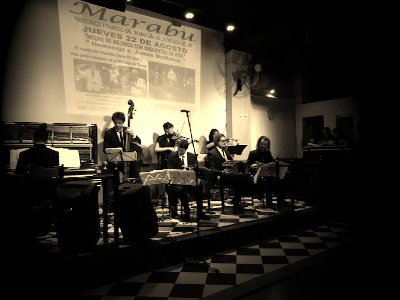El Marabú and ‘Como Dos Extraños’
The Marabú cabaret was born in the basement of an Italian-style building on calle Maipú 359 (where it still stands today), in the heart of the present Microcentro, in the same year that the famous Obelisk was installed : 1935. There you learned and lived the tango, the loves, the glamour, the disappointments. The cabaret was created by Jorge Sales, a Spaniard who knew how to capture the sensuality and mystery of a city characterized by solitude, immigration and tango. It was part of the radio circuit, bars and cabaret that fed the golden years of tango (years 40 of 1900) and the nocturnal imaginary of the middle class porteño: the footballers of "La máquina" (River Plate) were regular customers and they used to celebrate their championships at Marabú.
The name Marabú refers to an African bird and its feathers, which are used in the lingerie of the vixens and scarves of the women of the charleston and the "muñecas bravas" of tango.
The porteño cabarets of the 30’s (Tabaris, Casanova, Chantecler, Amenoville and others) had large circular tracks surrounded by tables with stages for two orchestras, a typical and a jazz. Usually they were not places for couples but for groups of men and women alone, where you could dance and meet. If a couple formed then hardly came back. The Marabu occupied a space of 1000 m2, with art deco style environments and black and white checkered floors. Al Marabù made his debut the orchestra of Anibal Troilo on 1 July 1937 with the singer Francisco Fiorentino, the maestro Carlos Di Sarli introduced Roberto Rufino, played Juan D'Arienzo and Angel D'Agostino.
Over the years, the Marabù closed and reopened several times as a local rock club and disco, until an American tango association, Argentine Tango Society, bought it at auction in 2014, renovating it and opening it to the public.
- Como dos extraños
The best known story about Marabú was written in verse by the poet Pascual Contursi in "Como dos extraños". A story of love and abandonment.
It all started when a beautiful girl from Cordoba, who had just arrived in the city and was still unprepared and defenceless, was hired among the 'coperas' (1) of the Marabú. He made friends with a waiter of the place, also from Cordoba. Soon they fell in love and between "cortes y quebradas" decided to live together forever. They worked in the cabaret for 2 years to save some money and return to live in Cordoba. The romance, determination, resolution and joy that they conveyed stunned and touched their friends. From the garbage man to the doorman, from the doorman to the manager, through the musicians, everyone admired that love built from below that shone as a hope for themselves. Until one night the unforeseeable happened.
That night a man, without any apparent reason , slapped the girl and continued to beat her. Her friends and the bartender intervened to remove the girl from the hands of the man who could not hit it anymore continued to insult her trying to free himself from the bartender who held him. The girl’s boyfriend attacked him with a marble ashtray, when the orchestra stopped and the man seemed to calm down, realizing that people were surrounding him. And before that audience he began to speak indignant to explain his gesture and be understood. And presented a marriage certificate as if it were a title of ownership. The silence of the girl was eloquent and the man took her away almost by pulling her hair.
After two years the waiter in love did not console himself. After failing to distract him in every way, his friends advised him to go and look for her. So he left for Cordoba in search of the girl he was still in love with. And he found her behind a counter in a warehouse in a suburb of Cordoba. He could hardly recognize her. She was fat, toothless, with a few hairs, unrecognizable. It didn’t seem like 2 years but 20 years.The young man couldn’t believe it and his eyes filled with tears. It wasn’t her, it wasn’t the same girl she was looking for. He returned to Marabú sadder than when he left.
The story circulated in cabaret and was collected by the poet José María Contursi who transformed it into a verse for the tango "Como dos extraños" with music by maestro Pedro Laurenz, which became very successful and had many versions over the years, The most famous are those of Laurenz-Casas and Canaro-Famà.
Umberto El Prince TDJ
(1) coperas : girls hired in the entertainment venues to entertain and dance with customers and share drinks (https://www.clarin.com/ciudades/adios-coperas-alternadoras-trabajar-boliches_0_HkSEdy1p.html).
Fonts
https://www.periodicovas.com/cabaret-marabu-una-historia-de-amor-y-abandono/
https://www.clarin.com/ciudades/cabaret-marabu-viaje-anos-dorados-tango_0_RD0y3i35_.html
https://www.lanacion.com.ar/espectaculos/el-marabu-la-cuna-del-tango-que-aun-mantiene-el-brillo-intacto-nid2153694
El Marabú and ‘Como Dos Extraños’ Read More »


